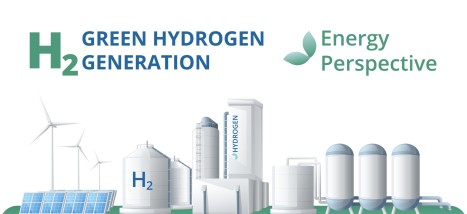-
19 December 2023

What exactly is green hydrogen?
For a colorless gas, hydrogen is described in very colorful terms. Time to explain the wonderful world of this form of energy (storage).
Companies and industry groups often come together to promote their own products. Much more unusual was the move last month by 10 major European energy companies and two of the continent's leading sustainable industry organizations, who banded together to launch a campaign touting a product that none of them actually sell. That product is renewable or "green" hydrogen. They all see that green hydrogen plays a crucial role in achieving a far-reaching decarbonisation of the energy system. Interest in green hydrogen is increasing enormously among large oil and gas companies.
What is green hydrogen? An introduction to the hydrogen color palette
According to the nomenclature used by market research firm Wood Mackenzie, most of the hydrogen already widely used as an industrial chemical is brown, if it is made by the gasification of coal or lignite; or grey, if made by steam methane reforming, which typically uses natural gas as the feedstock. None of these processes are now truly carbon friendly. A cleaner option is known as blue hydrogen, where the gas is produced by steam methane reforming, but emissions are limited by carbon capture and storage. This process could roughly halve the amount of carbon produced, but it is still far from emission-free. Green hydrogen, on the other hand, could nearly eliminate emissions by using renewable energy — which is becoming more abundant and often generated at less ideal times — to power the electrolysis of water. A more recent addition to the hydrogen production palette is turquoise. This is produced by breaking down methane into hydrogen and solid carbon using a process called pyrolysis. Turquoise hydrogen seems relatively low in terms of emissions, because the carbon can either be buried or used for industrial processes such as steelmaking or battery production, so it doesn't end up in the atmosphere. However, recent research shows that turquoise hydrogen is probably no more carbon-free than the blue variant, due to emissions from the natural gas supply and the required process heat.
How is green hydrogen made?
With electrolysis you only need water, a large electrolyser and a large amount of electricity to produce large amounts of hydrogen. If the electricity comes from renewable sources such as wind, sun or hydropower, the hydrogen is effectively green; the only carbon emissions come from those incorporated into the generation infrastructure. The challenge right now is that large electrolyzers are in short supply and abundant supplies of renewable electricity still come at a significant price. Compared to more established production processes, electrolysis is very expensive, so the market for electrolyzers was small. And while renewable energy production is now large enough to cause a duck curve in California and grid problems in Germany, overproduction is a relatively recent development. Most energy markets still need sufficient renewable energy to operate the grid.
How is green hydrogen stored and used?
Theoretically, you can do many useful things with green hydrogen. You can add it to natural gas and burn it in thermal energy or district heating plants. You can use it as a precursor for other energy carriers, from ammonia to synthetic hydrocarbons, or to directly power fuel cells in, for example, cars and ships. For starters, you can simply use it to replace the industrial hydrogen made every year from natural gas, which is about 10 million tons in the US alone. The biggest problem in meeting all these potential markets is to distribute green hydrogen to where it is needed. Storing and transporting the highly flammable gas is not easy; it takes up a lot of space and has a habit of making steel pipes and welds brittle and prone to cracking. As a result, the bulk transport of hydrogen requires special pipelines, which would be expensive to build, which pressurize the gas or cool it to a liquid. The latter two processes are energy-intensive and would further limit the already disappointing return efficiency of green hydrogen.
Why is green hydrogen suddenly such a hype?
One of the paths to near-complete decarbonisation is to electrify the entire energy system and use clean, renewable energy. But electrifying the entire energy system would be difficult, or at least much more expensive, than combining renewable generation with low-carbon fuels. Green hydrogen is one of many potential low-carbon fuels that can replace current fossil hydrocarbons. Admittedly, hydrogen is far from ideal as a fuel. The low density makes it difficult to store and move. And its flammability can be an issue, as an explosion of a Norwegian hydrogen filling station in June 2019 highlighted. But other low-carbon fuels also have problems, not least the cost. And since most of them require the production of green hydrogen as a precursor, why not just stick with the original product? Proponents point out that hydrogen is already widely used by industry, so technical problems with storage and transport are probably not insurmountable. In addition, the gas is potentially very versatile, with possible applications in areas ranging from heating and long-term energy storage to transportation. The ability to adopt green hydrogen in a wide range of sectors means there is a correspondingly large number of companies that could benefit from rapidly growing hydrogen fuel consumption. Perhaps the most important of these are the oil and gas companies that are increasingly faced with calls to cut back on fossil fuel production. Several major oil companies are among the players competing for the pole position in the development of green hydrogen. For example, Shell Nederland confirmed in May that it has joined forces with energy company Eneco to bid for capacity in the latest Dutch offshore wind tender, so that it can create a record-breaking hydrogen cluster in the Netherlands. Days later, BP's solar developer Lightsource BP revealed it was developing an Australian green hydrogen plant powered by 1.5 gigawatts of wind and solar capacity. Big Oil's interest in green hydrogen could be crucial to make the fuel commercially viable. Reducing the cost of green hydrogen production requires massive investment and large-scale economies of scale, which could put oil companies in a unique position.
How much does it cost to produce green hydrogen?
Green hydrogen is still expensive to produce today. In a report published last year (with data from 2018), the International Energy Agency estimated the cost of green hydrogen at $3 to $7.50 per kilo, compared to $0.90 to $3.20 for production using steam methane reformation. Reducing the cost of electrolyzers will be key to lowering the price of green hydrogen, but it will take time and scale. The cost of electrolyzers could be halved by 2040, the IEA said. The business case for green hydrogen requires very large amounts of cheap sustainable electricity because a considerable amount is lost during electrolysis. The efficiency of the electrolysis varies from about 60 to 80 percent, according to Shell. The efficiency challenge is compounded by the fact that many applications may require green hydrogen to power a fuel cell, leading to further losses. Some observers have theorized that green hydrogen production could clean up the excess renewable energy capacity of large production centers, such as Europe's offshore wind farms. However, given the still high cost of electrolysers, it is questionable whether green hydrogen project developers would be willing to shut down their electrolysers until renewable energy prices fall below a certain level. More likely, as already envisaged by Lightsource BP and Shell, developers will build green hydrogen production plants with dedicated assets for generating renewable energy in resource-rich locations.
Who is currently leading the production of green hydrogen?Green hydrogen seems to be on everyone's mind right now, with at least 10 countries looking to the gas for future energy security and potential exports. The country most recently jumping on the bandwagon is Portugal, which in May unveiled a national hydrogen strategy reportedly costing €7 billion until 2030. In addition to oil and gas companies, renewable energy developers see green hydrogen as an emerging market, with offshore wind leader Ørsted last month announced the first major project focused exclusively on the transport sector. In addition to such big names, a large number of smaller companies hope to get their hands on a piece of the growing green hydrogen pie. Companies like ITM Power may not be well known today, but if green hydrogen delivers on a fraction of its promise, it could one day become huge.
Of great importance are the initiatives that encourage private investors to invest in green hydrogen, preferably combined with investment in sustainable energy generation. With FutureEnergyFund, for example, it is also possible to invest directly in the development of green hydrogen, combined with investing in wind and solar in Germany.
Source: Greentech Media
-
25 March 2025
 Green hydrogen can contribute effectively to emissions reductionBy: Evertjan van Roekel
Green hydrogen can contribute effectively to emissions reductionBy: Evertjan van RoekelGreen hydrogen often, but certainly not always, leads to CO2 gains. This is evident from research in Nature Energy by Kiane de Kleijne of Radboud University and Eindhoven University of Technology. 'If you calculate the entire life cycle of green hydrogen production and transport, the CO2 gain can be disappointing. But if green hydrogen is produced from very clean electricity and in the region, it can really contribute to emission reductions.'
[Read more...] -
18 February 2025
 Renewable energy investment creates great potentialBy: Evertjan van Roekel
Renewable energy investment creates great potentialBy: Evertjan van RoekelAn investment in renewable energy offers an excellent financial return and a way to put your money to work for people and the environment. Sustainable energy investments also play a crucial role in tackling the global climate problem.
[Read more...]